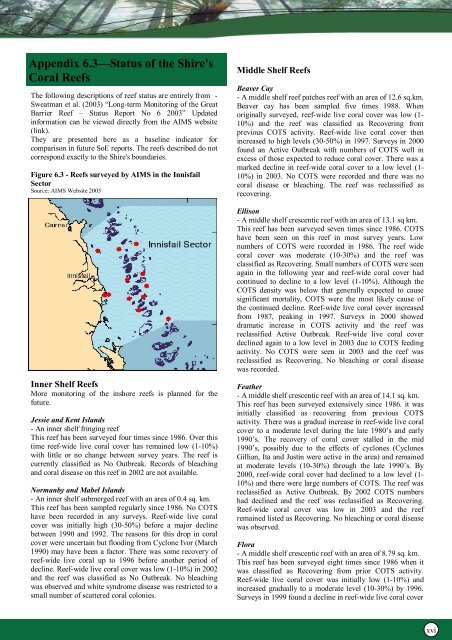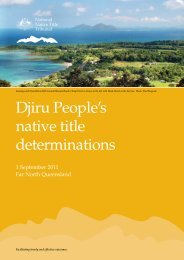Biodiveristy_State of Environment report - Mission Beach Cassowaries
Biodiveristy_State of Environment report - Mission Beach Cassowaries
Biodiveristy_State of Environment report - Mission Beach Cassowaries
- No tags were found...
You also want an ePaper? Increase the reach of your titles
YUMPU automatically turns print PDFs into web optimized ePapers that Google loves.
Appendix 6.3—Status <strong>of</strong> the Shire'sCoral ReefsThe following descriptions <strong>of</strong> reef status are entirely from -Sweatman et al. (2003) “Long-term Monitoring <strong>of</strong> the GreatBarrier Reef – Status Report No 6 2003” Updatedinformation can be viewed directly from the AIMS website(link).They are presented here as a baseline indicator forcomparison in future SoE <strong>report</strong>s. The reefs described do notcorrespond exactly to the Shire's boundaries.Figure 6.3 - Reefs surveyed by AIMS in the InnisfailSectorSource: AIMS Website 2005Inner Shelf ReefsMore monitoring <strong>of</strong> the inshore reefs is planned for thefuture.Jessie and Kent Islands- An inner shelf fringing reefThis reef has been surveyed four times since 1986. Over thistime reef-wide live coral cover has remained low (1-10%)with little or no change between survey years. The reef iscurrently classified as No Outbreak. Records <strong>of</strong> bleachingand coral disease on this reef in 2002 are not available.Normanby and Mabel Islands- An inner shelf submerged reef with an area <strong>of</strong> 0.4 sq. km.This reef has been sampled regularly since 1986. No COTShave been recorded in any surveys. Reef-wide live coralcover was initially high (30-50%) before a major declinebetween 1990 and 1992. The reasons for this drop in coralcover were uncertain but flooding from Cyclone Ivor (March1990) may have been a factor. There was some recovery <strong>of</strong>reef-wide live coral up to 1996 before another period <strong>of</strong>decline. Reef-wide live coral cover was low (1-10%) in 2002and the reef was classified as No Outbreak. No bleachingwas observed and white syndrome disease was restricted to asmall number <strong>of</strong> scattered coral colonies.Middle Shelf ReefsBeaver Cay- A middle shelf reef patches reef with an area <strong>of</strong> 12.6 sq.km.Beaver cay has been sampled five times 1988. Whenoriginally surveyed, reef-wide live coral cover was low (1-10%) and the reef was classified as Recovering fromprevious COTS activity. Reef-wide live coral cover thenincreased to high levels (30-50%) in 1997. Surveys in 2000found an Active Outbreak with numbers <strong>of</strong> COTS well inexcess <strong>of</strong> those expected to reduce coral cover. There was amarked decline in reef-wide coral cover to a low level (1-10%) in 2003. No COTS were recorded and there was nocoral disease or bleaching. The reef was reclassified asrecovering.Ellison- A middle shelf crescentic reef with an area <strong>of</strong> 13.1 sq km.This reef has been surveyed seven times since 1986. COTShave been seen on this reef in most survey years. Lownumbers <strong>of</strong> COTS were recorded in 1986. The reef widecoral cover was moderate (10-30%) and the reef wasclassified as Recovering. Small numbers <strong>of</strong> COTS were seenagain in the following year and reef-wide coral cover hadcontinued to decline to a low level (1-10%). Although theCOTS density was below that generally expected to causesignificant mortality, COTS were the most likely cause <strong>of</strong>the continued decline. Reef-wide live coral cover increasedfrom 1987, peaking in 1997. Surveys in 2000 showeddramatic increase in COTS activity and the reef wasreclassified Active Outbreak. Reef-wide live coral coverdeclined again to a low level in 2003 due to COTS feedingactivity. No COTS were seen in 2003 and the reef wasreclassified as Recovering. No bleaching or coral diseasewas recorded.Feather- A middle shelf crescentic reef with an area <strong>of</strong> 14.1 sq. km.This reef has been surveyed extensively since 1986. it wasinitially classified as recovering from previous COTSactivity. There was a gradual increase in reef-wide live coralcover to a moderate level during the late 1980’s and early1990’s. The recovery <strong>of</strong> coral cover stalled in the mid1990’s, possibly due to the effects <strong>of</strong> cyclones (CyclonesGillian, Ita and Justin were active in the area) and remainedat moderate levels (10-30%) through the late 1990’s. By2000, reef-wide coral cover had declined to a low level (1-10%) and there were large numbers <strong>of</strong> COTS. The reef wasreclassified as Active Outbreak. By 2002 COTS numbershad declined and the reef was reclassified as Recovering.Reef-wide coral cover was low in 2003 and the reefremained listed as Recovering. No bleaching or coral diseasewas observed.Flora- A middle shelf crescentic reef with an area <strong>of</strong> 8.79 sq. km.This reef has been surveyed eight times since 1986 when itwas classified as Recovering from prior COTS activity.Reef-wide live coral cover was initially low (1-10%) andincreased gradually to a moderate level (10-30%) by 1996.Surveys in 1999 found a decline in reef-wide live coral coverxvi



